The Scott
Jordan books, written by Harold Q. Masur (1909-2005), are a unique
combination of the hardboiled mystery novel and smart detective
work. Here’s a short look at the series by Gary Lovisi, written
first for Vintage Collectibles,
but which was updated and expanded for its appearance in Gary’s
long-running magazine Paperback
Parade #30, August 1992.
SCOTT JORDAN, THE HARD-BOILED LAWYER, by
Gary Lovisi
One of the best of the hard-boiled detectives, and one of the most neglected, is the fast-living lawyer Scott Jordan. Jordan is the creation of Harold Q. Masur, himself a practicing lawyer, born-and-educated in New York City, who now presents his cases as fiction. Masur’s lawyer-detective is a smart guy and can be a tough guy when he has to be, but basically he’s a decent guy trying to do his job and help his clients. He is definitely in the rugged Sam Spade mold, but he is a lot more human and humane. Scott Jordan novels are full of action and hard-boiled dialogue and description, but they also have interesting stories with good plot elements and skilled detection. It’s fun to follow Jordan on a case – he’s no Perry Mason and he’s no Mike Hammer, but he gets the job done, and he’s the kind of guy you don't want to mess with. He’s an intelligent man, an educated man, and a man who won’t stand still and allow another guy clean up a mess that’s been dumped in his lap. You could describe him as Sam Spade with.a law degree. He’s the type of lawyer that Perry Mason could have been but never was. Perry was watered down for more mass appeal. Scott Jordan is the real thing. The first novel in the series is Bury Me Deep, a great title that definitely sets the mood. It’s a fast-moving murder mystery that begins when Jordan comes home early to find a beautiful but unknown blonde half-dressed and very drunk in his apartment. From then on things get ever more complicated, as murder and intrigue rear their twin heads with Jordan stuck in the middle, trying to solve the crime and clear himself of a murder charge. The first paperback edition of Bury Me Deep was published by Pocket Books (#558) in 1948. It has a great hardboiled-good-girl cover by William Wirts. It was reprinted by Dell in 1957 and most recently by Quill in 1984. The Quill book is a nostalgic edition with a fine good-girl-art (GGA) cover obviously based on the original one by Wirts. 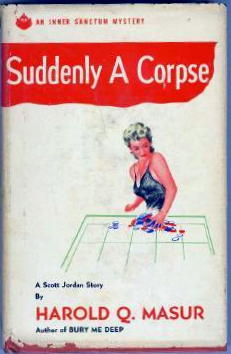 The second book, Suddenly a Corpse, was reprinted by Pocket Books (#704) in 1950. It has some great cover art by Barye Philips. One of the blurbs says: “Don't push your luck, baby! A
pretty gambler like you would make a prettier corpse.”
The story begins with a phone call and a dead man and escalates from there with fast action and some very good detection. It’s a good read. You Can’t Live Forever is the third book with a classic hardboiled title. This was done by Pocket Books (#860) in 1952 and has a wild Frank McCarthy cover featuring Jordan battling a pretty female murderess. The cover depicts the following wild scene from the novel: “I swarmed in and clamped a hand over her
mouth. It muffled the outcry but turned her into a frenzied
animal. She twisted and kicked and clawed. Fingernails
raked at my face. Spiked heels beat frantically against my
shins. She got one of my fingers between her teeth and tried to
amputate it.”
Rough stuff, and this was way back in 1952! So Rich, So Lovely, and So Dead is the fourth novel in the series. Pocket Books published it in paperback in 1953 (#988) with a dynamite Stanley Zuckerberg cover. It was later reprinted by Dell Books in 1961 (#D383) with a gorgeous Robert McGinnis cover. McGinnis’s cover was obviously influenced by the previous cover done by Zuckerberg. The pose of the woman is similar, after all, yet McGinnis has refined Zuckerberg’s idea and updated it. It’s much more vibrant and alive. Both of these covers are favorites of mine. They’re great work from two different eras, from two very individualistic artists. In this Scott Jordan novel we have a rich and beautiful countess, tagged by the newspapers as “the fabulous Screwball,” who seems to prove it to Jordan when she offers him $5,000 if he’ll marry her. Jordan never gets a chance to accept her proposition or to find out why it was offered, because in less than 24 hours, she’s murdered. Jordan finds himself in the soup again, and he has to find the real killer. You get the idea. This is good stuff. The other books in the series (see the bibliography below) are really worth your looking into. As readers, because this is excellent material to read; and as collectors, for even though he is very underrated, I believe Masur is also a very collectible mystery author.
Art Scott is both a long-time mystery fan and
a knowledgeable paperback
collector. In this article, reprinted with permission from Twentieth-Century
Crime and Mystery Writers, 3rd Edition,
published
by St. James Press, Art adds his
perspective to Hal Masur, the writer.
HAROLD Q. MASUR, by Art Scott
Because Harold Q. Masur is a lawyer, writing about lawyer-detective Scott Jordan, comparisons with ErIe Stanley Gardner’s Perry Mason are perhaps inevitable. There are more points of difference than similarity however. The Jordan tales generally eschew the elaborately staged courtroom scenes, replete with legalistic fireworks, that are the hallmark of the Perry Mason series. Masur, rather, draws on his legal background to provide plot springboards which turn on some interesting aspects of the law which Jordan encounters in his practice. The legal problem generally gives rise to the murder problem (in the Mason novels the murder usually is the legal problem). Jordan functions more as a conventional private detective, active away from the office and courtroom, and things are usually wrapped up before the legal proceedings are too far along. The Jordan books are tightly plotted, well clued and frequently surprising in denouncement, but they are not the elaborate (and frequently farfetched) Chinese puzzle box affairs that Gardner was so adept at devising. Jordan, who narrates his cases in the first person, is a relaxed, non-cynical sort of character, who often seems both distressed and bemused to find himself at the center of a web of greedy scheming and murder. Despite his low-key personality, though, Jordan is capable of fast action and quick thinking. He has a good working relationship with his police contact, homicide detective John Nola, though they are occasionally at odds when Jordan is forced to indulge in a bitofthin ice skating of the Mason variety. Jordan also relates well to the attractive women inevitably involved in his cases, in a not overly wolfish manner. The Jordan novels are compact and fast-paced, the dialogue is crisp and convincing, the supporting characters are free of the taint of cardboard. Murder motives are well-developed and credible. 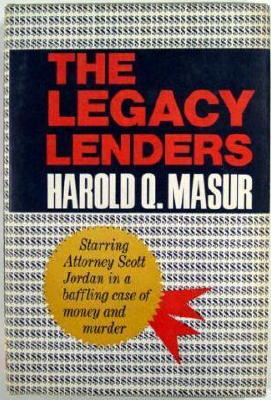 In The Legacy Lenders Jordan investigates a case involving a firm which lends money to prospective heirs on their “expectations.” The point at issue: do the lenders hurry things along a bit? Make a Killing finds Jordan in the midst of an involved proxy fight for control of a movie studio. In Tall, Dark, and Deadly Jordan’s career is at stake as he is accused of having faked evidence in a divorce case. Send Another Hearse concerns embezzlement at a literary agency and police corruption. This novel is particularly noteworthy for a shock plot twist seldom seen in series books – the murder of one of the continuing supporting characters. Masur has also written a number of short stories involving Jordan for the mystery magazines. His skill at maintaining a fast pace and tight plot serve him well in the short form. Ten of these tales were collected in the paperback anthology, The Name Is Jordan. Six years after publication of The Legacy Lenders, Masur resumed writing with an ambitious 1973 novel, The Attorney, an elaborate account of a sensational sex murder trial. The book focuses on the complexities of the criminal trial system, and on matters of legal ethics. The 1981 novel, The Broker, is less of a departure from Masur’s usual storytelling approach, though Jordan is again absent. The central story idea is a reworking of the theme of Make a Killing – financial plots and counterplots surrounding a proxy fight for control of a film studio – this time with greater emphasis on the intricacies of boardroom strategy, though murder is still very much present. HAROLD Q. MASUR: A BIBLIOGRAPHY, by Gary
Lovisi & Steve Lewis
Gary compiled the initial version of the following bibliography (Paperback Parade #30, August 1992), concentrating solely on Masur’s appearances in paperback form. In December 2005, Steve filled in some details and added the material on Masur’s appearances in hardcover. * = a Scott Jordan novel or story. Note: Some books were published as by Hal Q. Masur. These are not so indicated below. 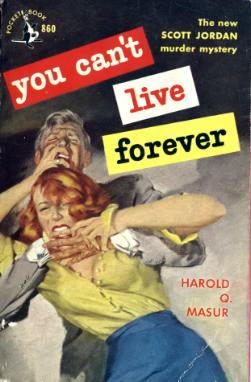 * Bury Me Deep. Simon & Schuster, hc, 1948. Pocket #558, 1st printing, Oct 1948. Cover: William Wirts. Pocket #558, 2nd pr., Dec 1948; 3rd pr., Jan 1949; 4th pr., Jan 1949. Note: The cover by Wirts appeared on all four printings. Dell #944, Apr 1957. Cover: Victor Kalin. T.V.Boardman, British hc, 1961. Bantam H4736, Dec 1969. Quill Books, 1984. Cover: Steve Macanga, redrawn from Pocket #558. * Suddenly a Corpse. Simon & Schuster, hc, 1949. T.V.Boardman, British hc, 1950. Pocket #704, July 1950. Cover: Barye Philips. T.V.Boardman #107,,British pb, 1952. Cover: Denis McLoughlin. Dell D250, Dec 1958. Cover: Victor Kalin. Bantam H5227, 1970. Cover: McGinnis? * You Can’t Live Forever. Simon & Schuster, hc, 1951. T.V.Boardman, British hc, 1951. Pocket #860, Feb 1952. Cover: Frank McCarthy. T.V.Boardman #130, British pb, 1953 Cover: Denis McLoughlin. Dell D329, Dec 1959. Cover: Robert McGinnis Pyramid T2340, Nov 1970. * So Rich, So Lovely and So Dead. Simon & Schuster, hc, 1952. 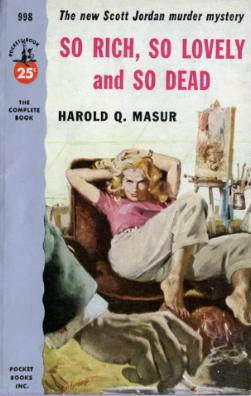 Pocket #998, Nov
1953. Cover: Zuckerberg. Pocket #998, Nov
1953. Cover: Zuckerberg.T.V.Boardman, British hc, 1953. T.V. Boardman #164, British pb, 1955. Cover: Denis McLoughlin. Phantom Books, Australian pb, 1959, as The Cool Corpse. Dell D383, Nov 1961. Cover: Robert McGinnis. Pyramid T2391, Jan 1971. Cover photo. * The Big Money. Simon & Schuster, hc, 1954. T.V.Boardman, British hc, 1955. Dell #874, 1956. Cover: Seymour Chwast. Phantom Books, Australian pb, 1957. Avon G1194, 1964. Berkley S1906, Nov 1970. * Tall, Dark and Deadly. Simon & Schuster, hc, 1956. T.V.Boardman, British hc, 1957. Dell D232, 1958. Avon G1233, 1964. Berkley S1921, Dec 1970. * The Last Gamble. Simon & Schuster, hc, 1958. T.V.Boardman, British hc, as The Last Breath, 1958. Dell D298, 1959, as Murder on Broadway. Cover: Victor Kalin. Note: A variant edition has a back cover ad for Paris Belts. Avon G1258, May 1965. Berkley S1968, 1971. 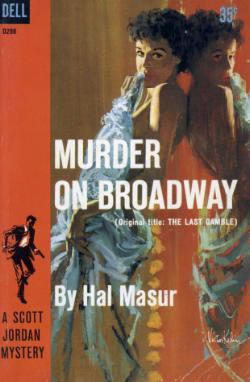 * Send Another Hearse. Random House, hc, 1960. T.V.Boardman, British hc, 1960. Dell 7377, Feb 1965. Cover: Greene. Raven House, June 1980; Nov 1980; Apr 1981. Photo cover. * The Name Is Jordan. Pyramid F-720, pb original, Apr 1962. Cover: Ron Lesser. - contents: Dead Issue • 1954 The Double Frame • Manhunt, June 1953 The Mourning After • Manhunt, Mar 1953 Over My Dead Body • Manhunt, Jan 1954 Rhapsody in Blood • Manhunt, Aug 1953 Richest Man in the Morgue • Manhunt, Dec 1953 Self-Defense • Manhunt, Feb 1955 Silent Butler • Ed McBain’s Mystery Book #2, 1960 Widow in Waiting • Dime Detective, Nov 1949 The Woman Who Knew Too Much • Manhunt, June 1956 Pyramid R1714, 1967. Photo cover. * Make a Killing. Random House, hc, 1964. T.V.Boardman, British hc, 1964. Avon G1259, 1965. * The Legacy Lenders. Random House, hc, 1967. T.V.Boardman, British hc, 1967. Bantam F3690, Apr 1968. Cover: Mitchell Hooks? 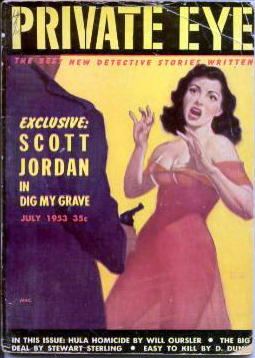 The Attorney. Random House, hc, 1973. Souvenir Press, British hc, 1974. Bantam T8330, July 1974. The Broker. St. Martin’s Press, hc, 1981. Souvenir Press, British hc, 1981. St. Martin’s Press, trade pb, 1983. Corgi, British pb, 1983. * The Mourning After. Raven House, pb original, 1981. Gollancz, British hc, 1983. Gryphon Double Novel #10. Gryphon Books, trade pb original, 1996. = contents: Dig My Grave (*) • Private Eye, July 1953. Shroud Me Not • Ten Detective Aces, July 1949. GHOSTWRITER: The Metropolitan Murders, as by Helen Traubel. Simon & Schuster, hc, 1951. Avon G1201, early 1960s. EDITOR: Dolls Are Murder. Lion Library LB152, pb original, 1957. An MWA anthology. Cover: Mort Kunsler. Murder Most Foul. Walker, hc, 1971. An MWA Anthology. Alfred Hitchcock Presents: Stories to Stay Awake By. Random House, hc, 1971. [Uncredited but thanked on the reverse of the title page.] Dell 8337, pb, September 1973. Alfred Hitchcock Presents: Stories to Be Read with the Lights On. Random House, hc, 1973. [Uncredited and unconfirmed.] Volume I: Stories to Be Read with the Lights On. Dell 4949, pb, 1976. Volume II: Breaking the Scream Barrier. Dell 4627, pb, 1976. – Dell, pb, 1979. Alfred Hitchcock Presents: Stories Meant to Be Read with the Doors Locked. Random House, hc, 1975. [Uncredited and unconfirmed.] Volume I: Stories Meant to Be Read with the Doors Locked. Dell 0138, pb, 1977. – Dell 10138, pb, 1981. Volume II: I Want My Mummy. Dell 13985, pb, July 1977. – Dell, pb, 1981. Alfred Hitchcock Presents: The Master’s Choice. Random House, hc, 1979. [Uncredited and unconfirmed.] COMMENT: Masur may have also been the editor of several other anthologies nominally edited by Alfred Hitchcock. These will be added later as the facts become known.
The following interview with the creator of the
Scott Jordan books also
appeared in Paperback Parade #30, August 1992. INTERVIEW WITH HAROLD Q. MASUR, by Gary
Lovisi
In May of 1991, I had the pleasure of visiting Harold Q. Masur at his apartment on Manhattan’s East Side. Hal was 81 years old then, a spry fellow, though he looked at least 20 years younger. He was robust and active, and a very sharp-minded individual, an attorney by profession and a best-selling mystery author by vocation. He supported himself by his writing since he came out of the Army in the late 1940’s. Hal’s first book was the now classic, Bury Me Deep. He received $500 for it from his hardcover publisher and $2,500 from Pocket Books in 1948 for the paperback edition. The book proved a bestseller and sold over a million copies in various Pocket Book printings. The royalties from this book enabled him to continue his writing career. Bury Me Deep was also optioned for a film, but that movie was never made. It’s unfortunate because it would have made a great hard-boiled film. In 1963 Hal was recommended by Bennett Cerf (founder of Random House) to Pentagon planners who wanted to create a roundtable to discuss Soviet aggression. They had assembled political, business and military leaders from all over the country and asked Hal to help them out. Then Chairman of the Joint Chiefs of Staff, General Curtis LeMay wanted a writer for the group, someone with imagination, and they couldn’t have picked a better person than Hal. Masur researched each story or novel thoroughly. Many of his short stories were based on actual landmark cases written up in law journals. Others were from personal experience. Hal was an attorney for almost 50 years, and although in semi-retirement in 1991, he was still visiting courtrooms to observe actual cases unfold. He had slowed down a bit since having quintuple bypass surgery earlier that year, but he had recovered when I visited him and was beginning to take up a full writing schedule again. Hal was still able to find time to help out friends, other writers, and the MW A with legal advice. He had recently arranged an adoption for a child into a warm and loving family. Hal Masur is a man who has made significant contributions to the mystery field. One of the Old Guard, he was a founder (with Bruno Fischer) of Mystery Writers of America (MWA) and was an officer of that organization for many years, serving as president in 1982-83, as well as a long-term legal counsel for the organization, giving many writers advice on copyright and contract law, essential in this business. The following interview gives only a brief introduction to this author’s long career in the mystery and detective genre. It was a real privilege and thrill for me to meet Hal. He’s a fine writer and a kind gentleman. The following interview was conducted Wednesday May 8, 1991, at Mr. Masur’s Manhattan apartment.
GL: What were the three names you used? HM: I wrote under the names of Edward James and Guy Fleming... GL: Guy Fleming? I’ve seen that name. HM: I had a lot of stories published under that name. And I got very close to this guy. He looked at me to produce. A few years later, maybe a year or two after that, I got drafted into the Army for World War II, and I wound up in China. GL: In 1943? HM: In 1944 I was drafted, and in 1944, I was in China. I got a letter from him and a letter from a guy who was doing fantasy and science fiction stuff, Donald Wollheim. He said he got my name from his father, who was a physician. I was living at that time, before the war, in the Hotel Ansonia with my mother. We had a tiny little place. I think Donald Wollheim’s father was the house physician. My mother had hurt herself and he came up and saw magazines all over the place and he said, where is your son? I have a son who’s an editor, he might be interested. Wollheim wrote me a letter. He had taken over some of the detective story magazines at Ace or some other outfit. He was desperate for material, the writers were all in the Army. So I went in to see the C.O. in the orderly room and told him the story, that I could make a couple of extra bucks, send it home, if I could use the typewriter in the orderly room at night. He said sure, no problem. After that I think I must have written about twenty stories while I was in China and shipped them to Wollheim and he bought them all. I told him to send the checks to my mother. I didn’t want to get them in China. Where the hell would I deposit them? . GL: How did you get into detective fiction? I heard you started off in the adventure pulps. HM: I think Hoffman at Adventure told me about some wonderful writers. These were guys writing detectivestories, Raymond Chandler, Dashiell Hammett, and a fellow named John Carroll Daly. Hoffman said I ought to read these guys because they were fantastic. I did. And I said, jeez, jf these guys can write like this, who needs the Saturday Evening Post? These guys are terrific. I’ll never be that good. But the pulps needed a lot of material, you know? Ten Detective Aces was published monthly and they needed ten stories. GL: That’s a lot. HM: And they had at least ten magazines, all kinds of detective story magazines, and then after a while they upped me from one-half cent to a penny. a word. So you did 5,000 words, you got fifty bucks. But fifty bucks in those days was real money. GL: That’s like five hundred today.
It’s now two or three years later and he hasn’t had a job yet. She’s supporting him. She’s tight for money, because she substitutes from time to time. But he’s a big brute of a guy, he’s always drunk, goes to the bar, comes back and he’d knock the hell out of her. She was a battered wife. You say, why would a woman tolerate that? Do you remember the pictures of that woman on TV, Hedda Nussbaum? Did you ever see anything like that in your life? Never complained. This woman was the same thing, docile, submissive. She’d cry when he beat her up but she’d never tell anybody. The neighbors heard her crying once, heard the noise and called the cops. He kicked the shit out of both cops, and did about thirty days. One day this guy comes home and he’s beaten up, he’s all bruised up. What happened was a bartender refused to give him any more credit. He climbed over the bar and started to beat up the bartender. The rest of the customers pile in and there was a big donnybrook. He comes home to her, and he wants more money. She says, we have to pay the rent next week or we’ll be evicted. That’s all she had to do, refuse him. He knocked her down, knocked her tooth out as a matter of fact. He kicked her. She crawled into the bedroom where he still had the gun that he had as a security guard. He never returned it. She got the gun, she was on her knees on the floor, and took it out of a low drawer. She said to him, don’t do this, I can’t stand it anymore. So he kicked her again and she fired two shots. The guy died. They took her to trial. I guess there’s no jury in the world that would convict a woman who had been battered at least thirty times, that’s on the record. They knew from police reports, neighbors. This was self-defense and so she was acquitted. Now the interesting thing in this case is this: that first week they were married he took out an insurance policy on himself for $100,000. He couldn’t pay the premium and they tried to say that she killed him because of the insurance. The insurance company had refused to pay because a felon may not profit from the “ fruits of their crime.” But when she was declared innocent... GL: She wasn’t a felon. HM: They sent her a check for a hundred grand. She sent the check back. Guy calls her on the phone and he says, what’s the problem, lady? She says, the policy had a double indemnity clause. You pay double in the case of death by accident. The guy says I don’t know what you’re smoking, you’re not gonna get it, this was no accident. She says, I’ll sue. He says, be my guest and he hung up. So she sued and she lost. Now she’s represented by my hero, Scott Jordan. He appeals the case. But this is actually what happened in Maryland. GL: This is a story coming out in Ellery Queen? HM: It’s appeared already, just last year. What happened was, she appealed the case. The case comes up before the appellate court. There are three justices. The presiding justice reads the decision. He says, “This insurance company has been in business for over ninety years. They know how to write an insurance policy. They have expensive attorneys to help them in the language. When they say they’re going to pay double in case of death by accident, that’s exactly what they mean. No more, no less. 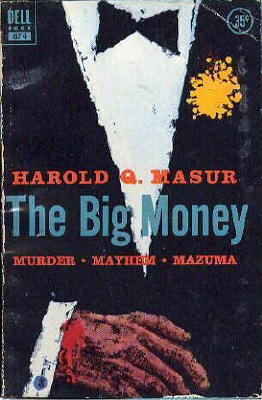 Now they can’t define the word ‘accident’ in order to accommodate their needs. Neither can the justices. They are not word experts. They’re not lexicographers. They have to go with the ultimate authority, Webster’s Unabridged Dictionary. And right there on the bench he opens the dictionary and he reads “accident.” There are two elements: one, an unexpected event, and two, it causes an injury. This man had beaten his wife thirty times. She had never complained. She never called the police. She never fought back. So when she pulled the trigger it was unexpected. Did it cause an injury? Oh boy! They gave her the whole $200,000. GL: And that’s a true case? HM: That’s a true case. I don’t even know if it’s good law. GL: They can’t prove it’s premeditated. HM: The only thing that could have indicated premeditation was the $100,000 insurance policy. That was the only thing. I did a great story for that. Sullivan at Ellery Queen bought it, and they sent me $525. It took me two days. I like to do short stories. I wish I could do a lot more of them. I did many for the pulps. Almost five hundred. GL: Bury Me Deep originally appeared in Mammoth Detective in 1947. How did that book come to be written? HM: You know who was the editor of Mammoth Detective? GL: No. HM: Howard. Browne, who wrote mystery stories under the name of John Evans. GL: He wrote Halo in Blood. HM: That’s the guy. He went to Hollywood, made a lot of money. GL: He wrote a new one, Pork City, that I have. I didn’t get to read it yet, but it looks really good. HM: I’ll tell you, it’s a great book. As a matter of fact, he called me from California, said, Hal, I’m retired, my wife is dead, I’m going to write again, who should I send it to? I said, send it to Joan Kahn at St. Martin’s Press and I’ll call and tell her to expect it. And she bought it immediately. It’s a good book. GL: It looks great. I like real hard-boiled stuff. I can’t wait to read it. HM: I didn’t even know he could write that well. You’ll enjoy it, it’s a beauty. As I was saying, Evans was the editor of Mammoth Detective. He bought Bury Me Deep for Mammoth Detective. That came about because when I was in the Army in China we had Armed Forces Editions. Those were paperbacks published specially for the Armed Forces. I had a guy with me at radio school in Chicago. 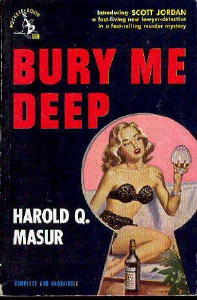 We were both sent to Madison, Wisconsin to teach radio there. He was a handsome Mormon guy about 6’3”, and we got very close. Wherever I went he would follow me. We came to a new camp and he would get me the best bunk and say to everybody, “I’m saving this for Masur.” Then I got shipped to China to set up. He said, I want to join Masur. Can you get me there? And they said, sure, they need radio guys there, and that’s how he came out. There was a guy in our barracks, who was a mystery fan. He gave me a copy of The Big Sleep, and I read that and boy, that was an eye-popper. And I said, as soon as I get back, I’m going to write a book. When I got out of the Army, my law office was gone, I had about one hundred twenty bucks. I went out to stay with my sister in Staten Island and I joined what they called the 52-20 club. I don’t think you know what that is. The Army was prepared to give every veteran $20 a week for 52 weeks until they could get settled into a job. GL: To get them on their feet. HM: Yes, to get on their feet when they came back home. That year I wrote Bury Me Deep, I had that money in which to take that gamble. GL: It’s a great book. HM: I took that book to Simon & Schuster, because I liked their Inner Sanctum Mysteries and left it at the reception desk with a little note: “Please read the first page. If you don’t like it send back the self-addressed postcard and I will pick it up.” Instead I had a call from Lee Wright who founded the Inner Sanctum Mysteries. She was their leading mystery editor and she said, “It’s a lovely book, I can’t believe it’s your first book.” And she published it and, we got very close. She died about two years ago. Pocket Books then was a division of Simon & Schuster and they did Bury Me Deep in paperback and it just simply took off. GL: It first appeared in the pulp magazine Mammoth Detective. HM: I had a problem with that. A couple of years ago a guy called me from Columbia Pictures. He said he was home, he had the flu, and was looking for something to read when he found a copy of Bury Me Deep on his wife’s bookcase. He read it, and he said it would make a terrific movie. He said he was still in bed with a fever, but he was coming to New York to talk to me about it. Well, he came here and stayed three or four days in New York, and I ate with him every day and we talked about it. Finally he called the legal department and told them to set up a contract. We’re going to buy this book from Masur. They did. Later, I got a call from their legal department, and they said, you know, we checked the book out and. found that was published in a pulp magazine a year before it came out and it was copyrighted by the pulp. Then it was copyrighted by you a year later. So there were two copyrights for the same book, which makes it defective.
HM: I had a number of different heroes, some of them under different names. GL: Was St. John another version of Scott Jordan? HM: No, I don’t think so. I just wanted to write about a lawyer. GL: He’s different, he’s not as hard-boiled, he’s more of an urbane kind of guy. In “Shroud Me Not,” Police Lieutenant John Nola also appears. He’s in that story with Harvey St. John, and he’s in the Scott Jordan stories. Why did you have him in both series? HM: You know, sometimes you like a particular name. I had read a lot of detective stories at that point, and generally the police officer, the private eye, was always a cop who was a big fat dumb Irishman. I decided to use a smart Italian to be different. They all had gorgeous secretaries. My first secretary was forty years old and fat. I wanted to be different from anybody else. 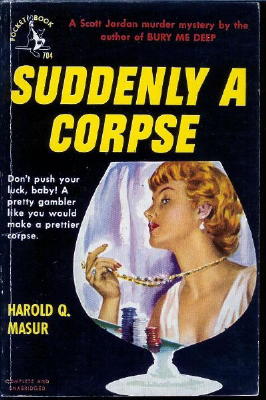 GL: Nola’s an
interesting character. In Suddenly
a Corpse, you describe him as “... a neat, slender man with a
dark, intelligent face, alert as a squirrel and tougher than
yesterday’s egg stains, inflexible and incorruptible, a career cop
who’d pulled himself up from the ranks and danced at the end of
nobody’s string. A cop all the way through, but a man with a
heart, and a man you could respect.” Sounds like the perfect cop
to me. Any comments? GL: Nola’s an
interesting character. In Suddenly
a Corpse, you describe him as “... a neat, slender man with a
dark, intelligent face, alert as a squirrel and tougher than
yesterday’s egg stains, inflexible and incorruptible, a career cop
who’d pulled himself up from the ranks and danced at the end of
nobody’s string. A cop all the way through, but a man with a
heart, and a man you could respect.” Sounds like the perfect cop
to me. Any comments?HM: I’m sure there are a couple like that. It seems that most of the time in those days, the early days, the cop was always the dumb Irishman, not as smart as the private eye, not as smart as anybody. I wanted a smart Italian. GL: He’s a good cop. HM: I wanted to be a little different. And I wanted a guy who they could respect. GL: Well, he’s tough but he’s fair. HM: I’m sure there are guys like that in the department. GL: Besides Harvey St. John and Scott Jordan, did you write any other series characters? HM: I had a private eye named Albert Catraz. He was known as Al Catraz. That was the kind of crap they wanted in those days. He was in some of the Guy Fleming stories. We used a lot of stuff like that, that would make people smile or catch on. You know the pulps, you’ve read them? There was a writer named Richard Sale. Richard Sale was something like John D. MacDonald. He could do anything and do it extraordinarily well. He was a consummate story teller and became very wealthy. He also wound up in Hollywood, writing, producing, directing. There were guys in the pulps who were talented beyond measure. GL: He wrote a lot of good books. HM: And I learned a lot from them until I found my own voice. I’ll tell you what I wanted for Scott Jordan. I wanted a guy who was as ingenious in law as Perry Mason, but who was as bright and as insouciant as Nero Wolfe’s Archie Goodwin. I wanted to get a combination between those two. Whether I ever achieved it or not, I don’t know. But that was the sort of a guy I wanted. GL: Where did Scott Jordan come from? How much of Hal Masur is in Scott Jordan? HM: Well, he’s a lot smarter than I am. A lot braver. I think that he is an idealized version of what I would have like to have been. He was an idealized version of the kind of lawyer I would have liked to have been, but I could not achieve. I’m not as smart as Scott Jordan. GL: It’s also very dangerous. The things that he was doing, and the cases that he had, there was a lot of danger. HM: Especially in Bury Me Deep. GL: Scott Jordan is a hard-boiled lawyer and private eye, he’s an intelligent man who uses his brain, a thinking man’s hard-boiled detective. What do you think about hard-boiled fiction? HM: If you were writing for the pulps in those days you had to be hardboiled. I suspect that as time went on, Scott Jordan became more soft-boiled, a little more civilized. It takes time to develop a human being and the cases he’s in. Let me tell you something about what I decided to do about Scott Jordan once he was underway. Most of the stuff then being written involved gangsters and the underworld, the Mafia and everything, and I decided that I wanted to write stories that were different from ErIe Stanley Gardner. I didn’t want a client coming into the office with a case. I wanted Scott Jordan personally involved. In every case he was a friend of the client or something was happening to him that was unusual, and in each book I wanted to pick out a business that would be the background of the book that I knew nothing about so I’d have to research it. In that way I felt that I could expand my own horizons, and at the same time try to synthesize information to give the reader something. GL: To give something new to the reader and for yourself. HM: I wrote The Mourning After about art forgery. I didn’t know anything about art at all. I spent time in the library checking it out, reading books about the impressionists, and I learned a little bit about the art world. Then I was a little bit fascinated by money and I had taken in some dough for Bury Me Deep, which I was lucky about because that started me off, and I could begin to write and didn’t have to think about going back to the law. I decided to do a book about Wall Street called The Broker. I didn’t get to write it until later on in my career because it was such a complicated subject, Wall Street. GL: This was begun a long time before? HM: The research was begun a long time before. Ididn’t know enough about it to develop a story. The stock market, investment banking, the S.E.C., all that stuff is very complicated. I began looking at the overall picture, how these guys operate. I’ve got a file on crooked brokers that you wouldn’t believe. I wouldn’t trust one of them, not any of them. There’s a conflict of interest. Their commissions, against your safety. And I wanted to find out, was there some way you could diddle a broker, take advantage of them. I worked out a scheme, and I tried it. I’m not going to mention the name of the broker. They sent me a check that I wasn’t entitled to. I got scared and sent it right back to them. I said, I’m going to write a book, and I’m going to use part of this scheme. GL: So this is all from research and the actual investigation? HM: Right, actual experience. I learned a lot about investing and the stock market. I read far beyond what I needed to know for a story. I even made some money on the market. On balance. I also lost. Nobody wins all the time. But I made some money on the market. When that book first came out I had a call from one of the attorneys on the Stock Exchange. He said he saw it in the window of Walden’s when he went to lunch with his colleagues, and he went in and bought it. He was fascinated and he asked if it would work? He said, why don’t you come down and have lunch with us, I’ll give you a tour of the Exchange. I went down and I became very friendly with this guy. I see him now occasionally. He just left the New York Stock Exchange, and he got a very big job with Merrill Lynch and we’re still friendly. I don’t ask him for any tips because I don’t want to get in trouble and he wouldn’t want to give them to me. 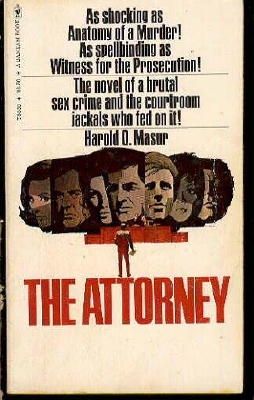 GL: The
Broker wasn’t a Scott Jordan
novel, but The Mourning After
was. GL: The
Broker wasn’t a Scott Jordan
novel, but The Mourning After
was.HM: The Attorney also was not a Scott Jordan novel. GL: Did either of those three come out in paperback? HM: The Attorney was published by Bantam. The Broker was done in a trade paper edition by St. Martin’s, but also it was published in abridged form by Harlequin in Canada. GL: Harlequin? Raven House books were published by Harlequin. They did Send Another Hearse. Raven House went under. They had a lot of books they didn’t get to publish. They may not have published it. HM: The guy from Harlequin, the editor that came to see me one day when he was in New York, said in order to introduce the line of Raven House Books, they would like to give every purchaser of a book a free copy of Send Another Hearse. In other words, it would be a complimentary copy. I said, if you give it away, how am I going to make royalties? And he said, I’ll talk to my boss. And they sent me a check. They really surprised me. They sent me a check for ten grand. GL: So Send Another Hearse was given out as a complimentary copy? HM: They may have gone under before they even did it. I don’t know. GL: They did three printings: June 1980, November 1980 April 1981. HM: I don’t know. I never even saw it. GL: It has a photograph cover. HM: That book was reviewed favorably by Boucher. He named it one of the best of the year. There were only two books he gave four stars to. I think that may be why they wanted it. GL: For me, Scott Jordan was the lawyer Perry Mason should have been, but wasn’t. What do. you think of the comparison between Mason and Jordan? HM: Boucher said the same thing. Boucher said, this is Perry Mason but with much better prose. GL: Also, the stories were more rich, more gripping, more realistic. HM: Perry Mason had wonderful gimmicky stuff. GL: Too much formula, though. HM: There wasn’t any decent characterization but it was readable stuff. Gardner was a pro, probably made as much money as anyone in the writing business. I’ll tell you a funny thing. I once gave a talk on Perry Mason, and I said, really, this guy doesn’t deserve too much credit because the District Attorney, Hamilton Burger, never failed in all the years through hundreds of books and short stories, to indict an innocent guy. He never nailed the actual perpetrator! He always had someone who was innocent. GL: He always lost the case. HM: This prosecutor was the world’s prime schmuck. Now I want to ask you something: the diminutive for Hamilton is Ham. So his name is Ham Burger. I wonder whether that ever occurred to Erie Stanley Gardner. GL: That’s interesting. HM: You ought to use that, it’s cute. This guy was a hamburger. How the hell could one guy, one district attorney, indict so many innocent people? GL: And with a record that bad, how could he stand for reelection? It would never happen. 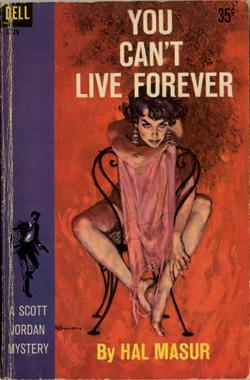 HM: As a matter of fact,
I think I did one or two Scott Jordans in which he lost the case, and
he lost because the guy was guilty. HM: As a matter of fact,
I think I did one or two Scott Jordans in which he lost the case, and
he lost because the guy was guilty.GL: That’s what I like about your books. They’re different. When you’re reading one of your books, you never know what’s going to happen. You can never figure it out. You think, he may do this, but then he may do something sneaky and something else will happen. What writers do you enjoy reading? What books are your favorites in the mystery genre? HM: My favorite writer by far was John D. MacDonald. I think he was a consummate story teller. This was a writer who could do anything and do it exceedingly well. These days I like Elmore Leonard. I don’t like his plots especially, his plots are weak, but his writing and his dialogue, it’s unique, it’s different. I can’t think of any other word ... it’s absolutely delicious stuff, wonderful stuff. There are two guys in this business that you couldn’t emulate at all. One is Elmore Leonard, and the other is Rex Stout. There are a couple of others who I like very much. I’ve read some things by Donald Westlake that I like. Andrew Vachss also. GL: Who did you like in the pulp days? HM: Dashiell Hammett, Raymond Chandler, John Carroll Daly, and of course Richard Sale, who I thought was as good as any of them. GL: What about Fredrick Nebel or Raoul Whitfield? HM: First rate, in the hard-boiled vein. That stuff looks kind of silly today when you look at it. I love to read it. These guys were masterful story tellers. In those days it was perfect. We needed heroes like that. Why do you think Mike Hammer was such a big success? Look, the world’s a goddamn mess. There’s more crime around. Somebody’s got to go out and put a stop to it. A guy like Mike Hammer was ready to do his share. GL: You’ve been a practicing lawyer all your life. How much of your law practice has entered into your writing? What Scott Jordan novels, particularly, were based on actual cases that you’ve done or things you’ve heard about? HM: It’s many years now that I’ve been counsel to the Mystery Writers of America, and I’ve been maintained in office for many years, but when I got out of the Army, a lawyer friend of mine said to me, Hal, do you need any dough? I need you as a witness in a divorce case. In those days there was only one ground for divorce and that was adultery. And most of the time it was collusion. You know what I mean? The husband didn’t find them. They set up a scene and they said, we’ve got a private eye who’s going to go to a hotel room, the woman’s going to be there with a guy, the detective will knock on the door, she’s going to be lying in bed covered and the guy’s going to be in his undershorts. And we’ll open the door. We’ll need two witnesses, you, and the private eye. I refused, but that was the gimmick that led to Bury Me Deep. 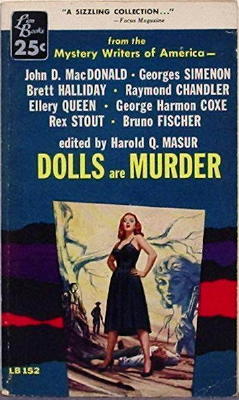 GL: In 1957, you edited a
Mystery Writers of America anthology for Lion Books, Dolls Are Murder. How did
that come about? GL: In 1957, you edited a
Mystery Writers of America anthology for Lion Books, Dolls Are Murder. How did
that come about?HM: The Mystery Writers were doing anthologies, one a year, and they had an offer from Lion Books, and they asked me to put together an anthology for them. I spoke to an editor there, and he said, look, we want big names, we don’t even care if they’re good stories, we want big names. So I called a bunch of the people that I knew at the time, John Dickson Carr, all the other old timers, and they all sort of took me under their wings and helped me out. That was because the first book, Bury Me Deep, was selling like crazy at the time. In a matter of three months they had six editions going, six printings. It ran away. The problem was, and it was a serious one, they printed close to a million copies in. that first printing. The book would sell for 25 cents, we got 6-8%, so there was a royalty of approximately two cents a book. Simon and Schuster got one penny, and I got one penny. Now you sell a million copies of a book at $4.95, and they’re paying 8%, you’re going to come out with a quarter of a million dollars. GL: You can really make some money. HM: You can make some money. On the other hand, if I could get five thousand – even in those days, because you know, bus fare was only a nickel, the Times was two cents – you know you could do something. I’ve never had a seller like Bury Me Deep again. I would love to sell a million copies of a book at $4.95. GL: What do you think of the cover art on your paperbacks? I see you have a few of the original paintings on display here. That’s a Victor Kalin original, those are Robert McGinnis originals for You Can’t Live Forever and Murder on Broadway. Robert McGinnis will also be a guest at my paperback show in October [1991]. HM: That will be nice. That will be excellent. I’d like to meet him. Those are the only original ones I managed to get. The publishers were ready to do anything for me. They thought I was going to be the new bright light, but I didn’t have that drive to turn out enough material. GL: You didn’t turn out the quantity, but you did turn out the quality. HM: And you know what that did for me? That meant that every book I had was published and republished and republished and sold all over the world in a dozen different languages because they were good books. GL: They’re still good books. A lot of people really enjoy them. What are you working on now? Are there any Scott Jordan books or films in the works? HM: I have a rough draft of a Scott Jordan novel about the publishing business, a funny sort of thing, but it’s a murder book. You know, I was operated on last year, and I decided to take a year off. So it’s hard to go back to it and polish it. I let my year run up until yesterday when I sat down and I worked all day on a short story. I’m going to be developing it, and I’ll do that over the next week or two. After that I just don’t know. GL: The Name Is Jordan was a collection of Scott Jordan stories. They had appeared in different magazines, Ellery Queen and others... HM: Maybe two or three had already appeared, I’m not sure. A lot of them appeared in a magazine called Manhunt and one appeared in Mike Shayne Magazine. I didn’t sell it to him. He asked me. It had been published somewhere, in a pulp or something and he saw it, and he liked it and wanted to buy it. GL: There’s no hard cover on that, that’s a first edition. That’s the only one of your Scott Jordan paperbacks that is a first edition? HM: That’s right. They did a second printing but with a different cover. GL: I remember when I first saw Bury Me Deep in the Quill edition, and I thought, what is this? I’ve got the same book home with a similar cover. 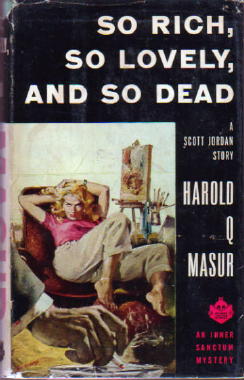 HM: It’s almost identical but not done as well. A guy at William Morrow told me it outsold several other Quill books. GL: I think that title is just so hard-boiled. HM: It’s a good complicated story. It’s the sort of thing I’m not sure I could write again. Part of that story was written in Staten Island, part was written elsewhere. I started to lay out the characters and the idea, after I read Raymond Chandler. As soon as I got out of the Army I went to work on Bury Me Deep. GL: The story you’re working on now, is that a Scott Jordan story? HM: It’s a Scott Jordan short story. I’ve got a terrific beginning for it. It’s about a stock manipulation, the takeover of a company, and insider trading. GL: After that, you’re going to work on the Scott Jordan novel on the publishing industry? HM: I have the entire rough draft of a book that’s been lying here for a year and a half. I’m anxious to finish it. GL: We’ll all look forward to reading that new one. YOUR COMMENTS ARE WELCOME. Material from Paperback Parade
#30 copyright
© 1992 by
Gary Lovisi. New material copyright ©
2006 by Gary Lovisi & Steve
Lewis. All rights reserved to contributors.
|



